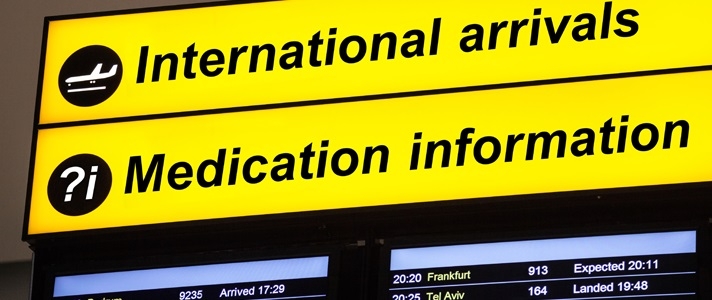How to bring medications into the U.S. from other countries
U.S. Food and Drug Administration (FDA)
You’re returning from a trip overseas and want to bring back over-the-counter drugs from Europe that aren’t available here. Can you?
Your mother-in-law is visiting from Mexico to help with the new baby and runs out of her blood pressure medication. Can she refill her prescription at a U.S. pharmacy?
Your foreign exchange student forgot his allergy medication. Can his parents mail it to him from Japan?
Those are just some of the questions people ask the Food and Drug Administration’s Division of Drug Information, says LCDR Lindsay E. Wagner, an FDA pharmacist, although not every question the division is asked falls under the FDA’s regulatory authority.
“As a pharmacist at the FDA, I advise people to remember, that we at FDA cannot ensure that medications approved in other countries are safe or effective, or have been manufactured properly,” says Wagner, PharmD.
So what are the rules for flying with or shipping medications? Here are some answers to common queries:
• Question: What should travelers and visitors know about bringing medications into the U.S.?
Answer: When you come to the United States with medications, you fall under the authority of FDA, U.S. Customs and Border Protection (CBP) and the Transportation Security Administration (TSA) agents operating the nation’s airports. There are varying restrictions, and different agencies may have other requirements or jurisdiction over a product. So check with each agency before you plan to travel with medications into the country.
In general, you should have with you a valid prescription or doctor’s note, written in English, to bring medication to the U.S. The medication should be in its original container with the doctor’s instructions printed on the bottle. If you don’t have the original container, bring a copy of your prescription or a letter from your doctor explaining your condition and why you need this medication. Travel with no more than you need for your personal use during your stay. A rule of thumb: Bring no more than a 90-day supply of medication.
If you’re staying longer than 90 days, you may have additional medication sent to you by mail or courier. Include documentation showing that the medication is being sent for your own use while visiting the United States. This documentation may include: a copy of your visa and passport, a letter from your doctor, and a copy of your prescription (in English).
• Question: What if there’s a generic available overseas but not here?
Answer: FDA does not permit personal importation of unapproved versions of FDA-approved drugs from foreign countries. FDA cannot assure that foreign-made versions of FDA-approved drugs have been properly manufactured, are safe and effective, and are the same formulation as the FDA-approved versions.
• Question: Can a foreign traveler get a prescription filled when visiting the U.S.?
Answer: If you’re traveling to the United States from another country and need a prescription filled, you should visit a health care provider. Very few pharmacies can fill a foreign prescription, and this is determined on a state-by-state basis.
• Question: Can you ship or mail a prescription medication to the U.S.?
Answer: In most cases, it’s illegal for people to import drugs into the United States for personal use. That’s because drugs available in other countries haven’t been evaluated or approved by FDA for use or sale in the U.S., so we can’t ensure that they’re safe and effective. FDA generally considers such drugs unapproved.
The FDA understands that there are cases in which someone may need treatment with a foreign drug that’s not available in the U.S. and there are no other U.S. medicines available to treat the condition. FDA’s Personal Importation Policy provides instructions for FDA personnel relating to the personal importation of drugs that may be illegal in the United States. The FDA considers the following when reviewing such an application:
*The drug is for a serious condition for which there is no effective treatment available in the U.S.
*There is no marketing or promotion of the drug to U.S. residents.
*The drug doesn’t represent an unreasonable health risk.
*You verify in writing that you’re importing the drug for your own personal use.
*You have a letter, written in English, from your doctor saying the drug is a continuation of treatment that began outside the United States or you provide the name and address of a U.S. licensed physician who will supervise your use of the foreign drug. The letter should accompany the package and be addressed to a Customs and Border Protection officer or broker.
*You’re not importing more than a three-month supply of the drug.
If the medicine is sent through the mail, Customs might detain it until an FDA inspector can examine it. This could take as long as a month. To speed things along, make sure the outside package is marked and states that it contains a letter to the U.S. Customs and Border Protection (CBP) officer or broker. The best option is to send the package by a courier service and flag it, so the U.S. Customs broker will alert FDA inspectors about the special circumstances for sending the package.
• Question: What else should you know about traveling with medications?
Answer: If you have questions for FDA about traveling with medications, contact the Division of Drug Information, by phone at 855-543-DRUG (3784) or email the FDA at druginfo@fda.hhs.gov.
The Drug Enforcement Agency (DEA) has other restrictions on bringing controlled substances into the country. Review those rules, § 1301.26, Exemptions from import or export requirements for personal medical use, at: www.accessdata.fda.gov/scripts/cdrh/cfdocs/cfcfr/CFRSearch.cfm?CFRPart=1301.
Contact the Transportation Security Administration (TSA) at www.tsa.gov/contact if you have questions about carrying prescription medications in your luggage or carry-on when flying. For more information, follow the TSA’s blog, Travel Tips Tuesday, at www.tsa.gov/blog/2013/06/11/travel-tips-tuesday-safely-packing-batteries-your-trip.
Visit the U.S. Customs and Border Protection website for additional information at www.cbp.gov/travel.
